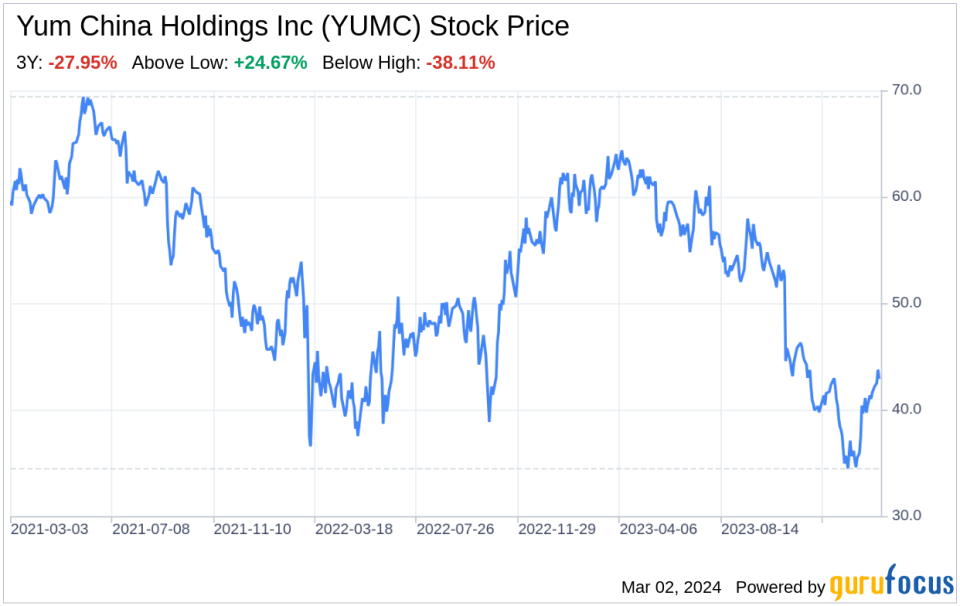Decoding Yum China Holdings Inc (YUMC): A Strategic SWOT Insight
Yum China Holdings Inc (NYSE:YUMC) boasts a robust portfolio with leading brands like KFC and Pizza Hut, driving its dominance in China's restaurant industry.
Despite a strong brand presence, YUMC faces regulatory challenges and competitive pressures in the dynamic Chinese market.
Opportunities for YUMC lie in expanding its digital capabilities and leveraging emerging brands to capture a larger market share.
Threats include potential regulatory changes and the ongoing competitive landscape that could impact YUMC's market position.
On February 29, 2024, Yum China Holdings Inc (NYSE:YUMC) filed its 10-K report, revealing a year of substantial growth and resilience. As the largest restaurant company in China, YUMC reported $11 billion in revenues for 2023, with a vast network of 14,644 restaurants. The company's success is anchored in its flagship brands, KFC and Pizza Hut, complemented by emerging brands such as Lavazza and Taco Bell. This SWOT analysis delves into the strengths, weaknesses, opportunities, and threats as disclosed in the 10-K filing, providing investors with a comprehensive understanding of YUMC's strategic positioning.

Strengths
Market Leadership and Brand Portfolio: Yum China Holdings Inc (NYSE:YUMC) stands as a titan in China's restaurant industry, with a commanding presence and a diverse brand portfolio. The company's flagship brands, KFC and Pizza Hut, are household names, contributing significantly to its $11 billion revenue in 2023. YUMC's strategic partnerships, such as the joint venture with Lavazza, showcase its commitment to expanding its offerings and capturing new market segments. The company's mastery in localizing global brands to suit Chinese tastes has been a key driver of its sustained dominance.
Operational Expertise and Expansion Potential: With over 35 years of operational experience in China, YUMC has honed its ability to navigate the complex Chinese market. The company's extensive network covers over 2,000 cities, indicating a deep market penetration and a strong understanding of regional consumer preferences. YUMC's strategic expansion plans, underscored by its ambition to further penetrate the Chinese market, signal potential for continued growth and an ability to leverage its operational expertise to maximize its expansive footprint.
Weaknesses
Regulatory and Market Risks: YUMC's operations are subject to stringent regulatory environments in China, which pose potential risks to its business model. The company's reliance on dividends from its Chinese subsidiaries, which are subject to a 10% Chinese withholding income tax, reflects a vulnerability to changes in tax regulations. Additionally, the complexities of currency conversion and capital contribution regulations could impact YUMC's liquidity and ability to fund its business, as well as its expansion efforts within China.
Dependence on Chinese Market: YUMC's financial health is heavily reliant on its performance in the Chinese market. While this focus has facilitated deep market penetration, it also exposes the company to economic fluctuations and consumer trends within a single geographic region. This concentration increases the risk of adverse impacts from local economic downturns, shifts in consumer preferences, or other region-specific challenges that could affect YUMC's revenue streams and growth trajectory.
Opportunities
Digital Transformation and Innovation: YUMC has the opportunity to further embrace digital transformation to enhance its customer experience and operational efficiency. The company's investment in digital initiatives, such as mobile ordering and delivery platforms, positions it to capitalize on the growing trend of online food services in China. By continuing to innovate and integrate technology into its business model, YUMC can attract a tech-savvy consumer base and streamline its operations to remain competitive in the fast-paced restaurant industry.
Emerging Brands and Market Trends: The growth of YUMC's emerging brands, including Lavazza and Taco Bell, presents significant opportunities to diversify its revenue streams and cater to evolving consumer tastes. As the Chinese market continues to show an appetite for new dining experiences, YUMC's ability to scale these brands and introduce new concepts could drive future growth. Additionally, leveraging its established market presence to explore untapped cities and regions within China could yield substantial rewards.
Threats
Regulatory Changes and Compliance: The regulatory landscape in China is dynamic and can pose significant threats to YUMC's operations. Changes in laws governing foreign investments, currency conversion, and taxation could materially impact YUMC's financials and its ability to conduct business effectively. The company must navigate these regulatory waters with caution, as non-compliance or adverse changes could lead to increased costs, penalties, or restrictions on its operations.
Competitive Pressures and Market Saturation: YUMC operates in a highly competitive market, contending with both international and domestic brands. As the market matures, the risk of saturation increases, potentially leading to intensified competition for market share, consumer attention, and prime restaurant locations. YUMC must continue to innovate and differentiate its offerings to maintain its competitive edge and appeal to a diverse customer base.
In conclusion, Yum China Holdings Inc (NYSE:YUMC) exhibits a strong market position with a robust brand portfolio and significant operational expertise. However, it must navigate regulatory uncertainties and market concentration risks. Opportunities for growth through digital innovation and brand expansion are countered by the threats of regulatory changes and competitive pressures. YUMC's strategic approach to these factors will be crucial in maintaining its leadership in China's restaurant industry.
This article, generated by GuruFocus, is designed to provide general insights and is not tailored financial advice. Our commentary is rooted in historical data and analyst projections, utilizing an impartial methodology, and is not intended to serve as specific investment guidance. It does not formulate a recommendation to purchase or divest any stock and does not consider individual investment objectives or financial circumstances. Our objective is to deliver long-term, fundamental data-driven analysis. Be aware that our analysis might not incorporate the most recent, price-sensitive company announcements or qualitative information. GuruFocus holds no position in the stocks mentioned herein.
This article first appeared on GuruFocus.
